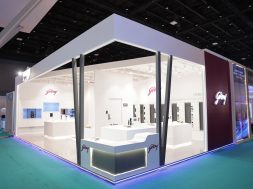Harnessing natural light and ventilation for sustainable buildings

“We largely opt for sustainable materials and incorporate green elements into our designs, seamlessly blending functionality with beauty.” Ar. Nikita Bajaj Pathak, Founder, Design21.
The conversation delves into the meticulous design processes and collaborative efforts with lighting experts, culminating in buildings that perform efficiently and contribute positively to the surrounding environment.
How do you incorporate passive design strategies, such as orientation and shading, to optimise energy efficiency in your building projects?
In our projects, we meticulously analyse the site’s orientation to maximise the use of natural light and minimise heat gain. We strategically place windows and openings to capture prevailing breezes for natural ventilation. Additionally, we use shading devices like overhangs and louvres to control sunlight penetration, preventing unnecessary heat gain and glare. This approach helps reduce the reliance on artificial cooling and lighting systems, ultimately optimising energy efficiency.
How do you address the balance between energy efficiency and aesthetic considerations in your architectural designs?
Achieving a balance between energy efficiency and aesthetics is a core principle in our practice. We largely opt for sustainable materials and incorporate green elements into our designs, seamlessly blending functionality with beauty. Our team collaborates with lighting designers to create visually appealing spaces while optimising natural lighting. This holistic approach ensures that our buildings perform efficiently and contribute positively to the surrounding environment.

Can you describe your approach to optimising natural lighting in buildings to minimise the need for artificial lighting and enhance energy efficiency?
Our approach to optimising natural lighting involves carefully placing windows and skylights to maximise daylight penetration. We conduct daylighting simulations to determine optimal locations for openings, ensuring a balanced light distribution throughout the interior. This meticulous planning minimises the reliance on artificial lighting during daylight hours, significantly reducing energy consumption and creating well-lit, energy-efficient spaces.
How do you approach selecting energy-efficient materials and technologies for your projects, considering both environmental impact and long-term energy savings?
Our commitment to sustainability is reflected in our meticulous selection of materials and technologies. We favour materials with third-party certifications for environmental performance and prioritise those with long life spans. Energy-efficient technologies, such as solar panels and smart building systems, are seamlessly integrated into our designs. This dual focus on environmental impact and long-term energy savings ensures that our projects are eco-friendly and economically viable in the long run.
What design strategies and technologies do you prioritise in net-zero projects to achieve energy neutrality and reduce environmental impact?
In pursuing net-zero goals, we focus on passive design strategies and cutting-edge technologies. Building orientation, thermal mass, and natural ventilation are key elements in minimising energy demand. We incorporate solar panels, advanced energy storage solutions, and energy-efficient appliances to generate and manage power efficiently. Smart building controls and real-time energy monitoring play a crucial role in achieving and maintaining energy neutrality, reducing the overall environmental impact of our net-zero projects.
Cookie Consent
We use cookies to personalize your experience. By continuing to visit this website you agree to our Terms & Conditions, Privacy Policy and Cookie Policy.










